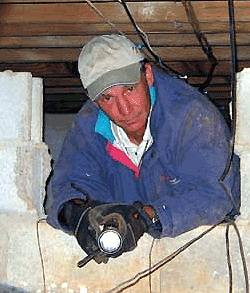|
Energy Tips - "Outside the Envelope" (of conditioned space)
![[Image]](../images/roof.gif) THE SITE THE SITE
 Landscaping Landscaping
Landscaping serves a functional as well as aesthetic role in the home. In his famous book on architecture the Roman architect and engineer Vitruvius states "designs for houses ought to conform to the nature of the country and to diversities of climate." Feng Shui, the Chinese art of design, grew from the efforts of the Chinese rulers to disseminate building standards throughout their kingdom.
The orientation or "aspect" of a home; North, South, East, West, affects how much heating and cooling is needed to maintain comfort levels. Trees and other vegetation can reduce the amount of energy needed as well as enhance outdoor comfort and enjoyment. Cooling loads are higher in West facing rooms, especially if they have large, unprotected expanses of glass. North facing walls suffer from the lack of direct sunlight. Heating loads due to shade and prevailing winter winds are higher.
Planting trees and other vegetation lower summertime temperatures an average of 8 degrees. Shade trees take 30-70 years to mature, under-canopy vegetation takes proportionally less time.
Shade trees may be planted on the South, West, and East sides of a home. The greatest amount of sun protection is gained on the West/Southwest exposure. Trees appropriate for Atlanta's climate include:
OAKS
- Varieties of the Water, Red, and Nuttal Oak
- White Oak is considered prime because of its coloring, strength and high quality wood.
MAPLES
- Varieties of Sugar Maple like Green Mountain and Legacy
- Silver Maples do not thrive in Atlanta.
EVERGREENS
Dense evergreen trees and shrubs block harsh winter winds. Trees and shrubs suitable for Atlanta include:
- MAGNOLIAS
- LEYLAND CYPRESS
- UPRIGHT HOLLIES
- Savannah, Carolina, and Nellie R. Stevens are suitable.
- ENGLISH LAUREL
- CRYTOMERIA JAPONICA
Know the mature size of trees and shrubs before you plant. The most common landscape mistake is spacing vegetation too closely, either to other plants or the house. Trees should not be planted close to driveways, walks, and patios as their roots will damage the pavement. Homes on small or steep lots limit the use of larger trees. Check with a landscape architect or designer for these or other special situations.
 Grading and Drainage: Grading and Drainage:
The saying goes "It's not the heat, it's the humidity."
- Control of moisture around the home increases efficiency and comfort.
- Consistent moisture levels are more easily maintained inside the conditioned space when surrounding areas are dry.
- Crawl spaces may be susceptible to bulk moisture in part because there are no waterproofing requirements for "uninhabitable" under-floor areas. Crawl vents allow airborne moisture air contact with framing, pipes and ducts.
- Basements require deeper excavation than crawl spaces. Their floors are "closer" to seasonal high water tables and are subject to higher soil and moisture loads.
- Measures to reduce bulk moisture around the perimeter of the home include:
- Maintain roof drainage: Keep gutters clean and properly pitched, pipe downspouts away from foundation walls.
- Create a positive slope away from foundation walls. Install drains, swales, or retaining walls, add soil where backfill has settled. Fill voids under walks, stoops and patios.
- If bulk moisture (visible signe of water) is controlled airborne moisture can be reduced by closing crawl or basement vents.
THE ENCLOSURE
 Attics and Under-floor spaces Attics and Under-floor spaces
Attics, crawlspaces, and unconditioned basements are buffer or transition areas. The term given in building science is "pseudo-conditioned space".
Temperature and humidity in these areas should fall between the levels of outdoors and the conditioned space. For instance: If the outside temperature is 25 degrees with a humidity of 15% while indoors it is 70 degrees and 40% the buffer areas should measure approximately 45-50 degrees and 25-30% respectively.
Moderating the attic temperature in the summer is difficult. Roof coverings act as a solar furnace; radiant energy from the sun can raise attic temperatures above 130 degrees F.
Landscaping, grading, drainage, attics, and under-floor spaces can dramatically affect energy usage and the comfort of your home. |
|
|
|

![[Image]](../images/roof.gif)

